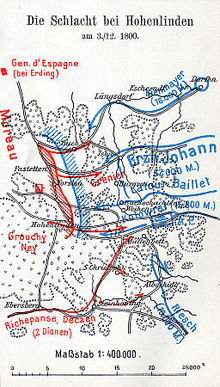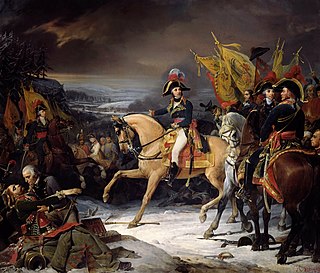
The Battle of Hohenlinden was fought on 3 December 1800 during the French Revolutionary Wars. A French army under Jean Victor Marie Moreau won a decisive victory over an Austrian and Bavarian force led by 18-year-old Archduke John of Austria. The allies were forced into a disastrous retreat that compelled them to request an armistice, effectively ending the War of the Second Coalition. Hohenlinden is 33 km east of Munich in modern Germany.
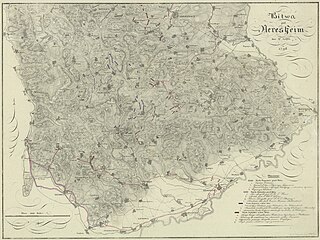
The Battle of Neresheim was fought by the Republican French army under Jean Victor Marie Moreau against the army of the Habsburg monarchy of Archduke Charles, Duke of Teschen. Pursued by Moreau's Army of Rhin-et-Moselle, Charles launched an attack against the French. While the Austrian left wing saw some success, the battle degenerated into a stalemate and the archduke withdrew further into the Electorate of Bavaria. Neresheim is located in the state of Baden-Württemberg in Germany a distance of 57 kilometres (35 mi) northeast of Ulm. The action took place during the War of the First Coalition, part of a larger conflict called the French Revolutionary Wars.
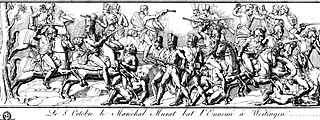
In the Battle of Wertingen Imperial French forces led by Marshals Joachim Murat and Jean Lannes attacked a small Austrian corps commanded by Feldmarschall-Leutnant Franz Xaver von Auffenberg. This action, the first battle of the Ulm Campaign, resulted in a clear French victory. Wertingen lies 28 kilometres (17 mi) northwest of Augsburg. The combat was fought during the War of the Third Coalition, part of the Napoleonic Wars.

The Battle of Würzburg was fought on 3 September 1796 between an army of the Habsburg monarchy led by Archduke Charles, Duke of Teschen and an army of the First French Republic led by Jean-Baptiste Jourdan. The French attacked the archduke's forces, but they were resisted until the arrival of reinforcements decided the engagement in favor of the Austrians. The French retreated west toward the Rhine River. The action occurred during the War of the First Coalition, part of the French Revolutionary Wars. Würzburg is 95 kilometres (59 mi) southeast of Frankfurt.
Johann Sigismund Graf von Riesch joined the army of Habsburg Austria as a cavalry officer and, during his career, fought against the Kingdom of Prussia, Ottoman Turkey, Revolutionary France, and Napoleon's French Empire. He became a general officer during the French Revolutionary Wars and held important commands during the War of the Second Coalition. He displayed a talent for leading cavalry formations, but proved less capable when given corps-sized commands. During the 1805 Ulm Campaign in the Napoleonic Wars, the French badly defeated his corps and forced it to surrender soon afterward. From 1806 to his death in 1821, he was the Proprietor (Inhaber) of an Austrian cavalry regiment.

The Battle of Ettlingen or Battle of Malsch was fought during the French Revolutionary Wars between the armies of the First French Republic and Habsburg Austria near the town of Malsch, 9 kilometres (6 mi) southwest of Ettlingen. The Austrians under Archduke Charles, Duke of Teschen tried to halt the northward advance of Jean Victor Marie Moreau's French Army of Rhin-et-Moselle along the east bank of the Rhine River. After a tough fight, the Austrian commander found that his left flank was turned. He conceded victory to the French and retreated east toward Stuttgart. Ettlingen is located 10 kilometres (6 mi) south of Karlsruhe.

At the Battle of Ampfing on 1 December 1800, Paul Grenier's two divisions of the First French Republic opposed the Austrian army southwest of the town of Ampfing during the French Revolutionary Wars. The Austrians, under the leadership of Archduke John of Austria, forced their enemies to retreat, though they sustained greater losses than the French. Ampfing is located 63 kilometers east of Munich and 8 km (5.0 mi) west of Mühldorf am Inn.

Count Ignác Gyulay de Marosnémeti et Nádaska, Ignácz Gyulay, Ignaz Gyulai was a Hungarian military officer, joined the army of the Habsburg monarchy, fought against Ottoman Turkey, and became a general officer during the French Revolutionary Wars. From 1806 he held the title of Ban of Croatia. In the struggle against the First French Empire during Napoleonic Wars, he commanded army corps. At the time of his death, he presided over the Hofkriegsrat, the Austrian Council of War.
Franz Anton Freiherr von Elsnitz was an Austrian cavalry soldier and commander during the War of the Bavarian Succession, Austro-Turkish War (1787–91), and French Revolutionary Wars.

Franz Freiherr von Werneck, enlisted in the army of Habsburg Austria and fought in the Austro-Turkish War, the French Revolutionary Wars, and the Napoleonic Wars. He had a distinguished career until 1797, when he was dismissed for losing a battle, and reinstated in 1805. In that year he surrendered his command and was later brought up on charges. He died while awaiting a court-martial.
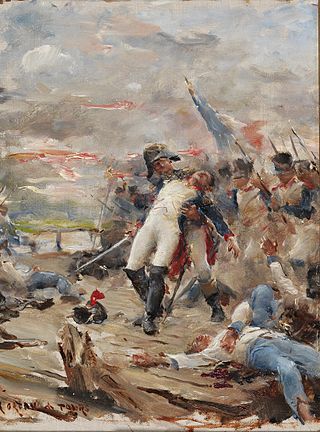
The Battle of Günzburg on 9 October 1805 saw General of Division Jean-Pierre Firmin Malher's French division attempt to seize a crossing over the Danube River at Günzburg in the face of a Habsburg Austrian army led by Feldmarschall-Leutnant Karl Mack von Lieberich. Malher's division managed to capture a bridge and hold it against Austrian counterattacks. The battle occurred during the War of the Third Coalition, part of the larger Napoleonic Wars.

The Battle of Biberach was fought on 2 October 1796 between a French Republican army led by Jean Victor Marie Moreau and a Habsburg Austrian army led by Maximilian Anton Karl, Count Baillet de Latour. The French army paused in its retreat toward the Rhine River to maul the pursuing Austrians. The action occurred during the War of the First Coalition, part of the French Revolutionary Wars.
The Battle of Friedberg was fought on 24 August 1796 between a First French Republic army led by Jean Victor Marie Moreau and a Habsburg Austrian army led by Maximilian Anton Karl, Count Baillet de Latour. The French army, which was advancing eastward on the south side of the Danube, managed to catch an isolated Austrian infantry regiment. In the ensuing combat, the Austrians were cut to pieces. Friedberg is a Bavarian town located on the Lech River near Augsburg. The action was fought during the War of the First Coalition.
Michael, Freiherr von Fröhlich was a German general officer serving in army of the Austrian Empire, notably during the Wars of the French Revolution.

In the Rhine campaign of 1796, two First Coalition armies under the overall command of Archduke Charles outmaneuvered and defeated two French Republican armies. This was the last campaign of the War of the First Coalition, part of the French Revolutionary Wars.

The Second Battle of Kehl occurred on 18 September 1796, when General Franz Petrasch's Austrian and Imperial troops stormed the French-held bridgehead over the Rhine river. The village of Kehl, which is now in the German state of Baden-Württemberg, was then part of Baden-Durlach. Across the river, Strasbourg, an Alsatian city, was a French Revolutionary stronghold. This battle was part of the Rhine Campaign of 1796, in the French Revolutionary War of the First Coalition.
The Battle of Maudach occurred on 15 June 1796 between the French Revolutionary Army and the Army of the First Coalition. This was the opening action of the Rhine Campaign of 1796 on the Upper Rhine, slightly north of the town of Kehl. The Coalition, commanded by Franz Petrasch, lost 10 percent of its manpower missing, killed or wounded. It was fought at the village of Maudach, southwest of Ludwigshafen on the Rhine river opposite Mannheim. Maudach lies 10 km (6 mi) northwest of Speyer and today is a southwest suburb of Ludwigshafen; a principal town on the Rhine river in 1796.
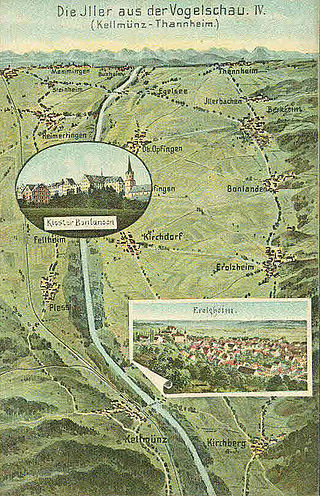
The Battle of Iller River or Battle of Erolzheim saw a French Republican army led by Jean Victor Marie Moreau fight a Habsburg Austrian army led by Paul Kray. In late May, the adversaries reached a stalemate with the Austrian army holding Ulm and the French army facing it from the south. Both armies numbered about 80,000 men. Kray launched an attack against the French left wing along the Iller River at Erolzheim and Illertissen, but he withdrew his troops when Moreau sent reinforcements. The action occurred during the War of the Second Coalition, part of the French Revolutionary Wars.
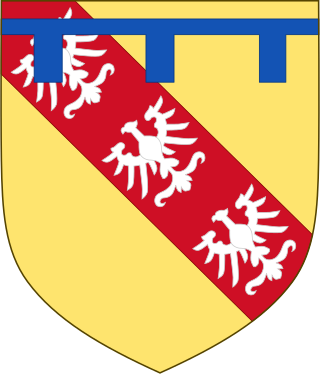
Joseph Maria Louis, Prince of Lorraine-Vaudémont served as an Austrian general during the French Revolutionary Wars. Born into a noble family in France, he went into exile in 1791 during the French Revolution and offered his services to the Habsburg monarchy. He fought in the Austrian army during the War of the First Coalition, rising in rank from leading a cavalry regiment to commanding a brigade. He led a division during the War of the Second Coalition and the War of the Third Coalition. He died in Hungary in 1812.

Johann Rudolf von Sporck or Spork served as an Austrian general during the French Revolutionary Wars. He fought in the Austro-Turkish War in 1789–1790. He led an infantry regiment in 1792–1793 and was promoted Generalmajor at the beginning of 1794. He fought in the Flanders campaign in 1792–1794 and in the Rhine campaign of 1795. After being transferred to Italy, he led a brigade at Lonato, Rovereto, and Calliano in 1796. He was promoted to Feldmarschall-Leutnant in 1797 and led a division in 1800 at Engen, Messkirch, and the Iller River. In 1801 he became the inhaber (proprietor) of an infantry regiment. He died in 1806.


